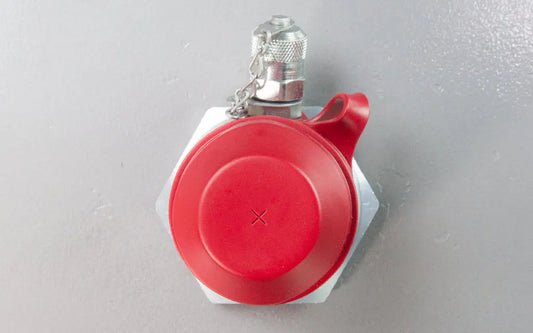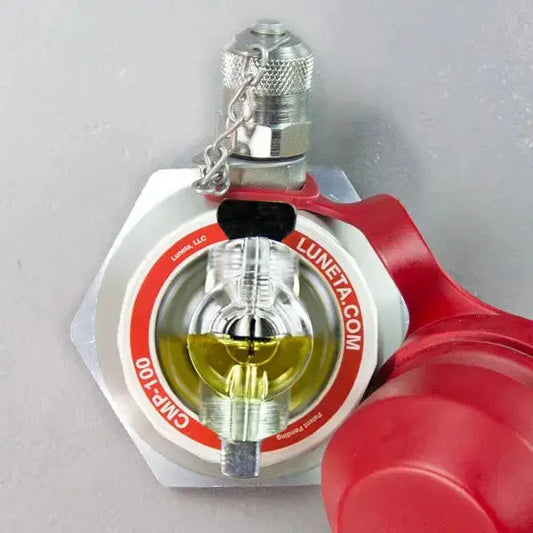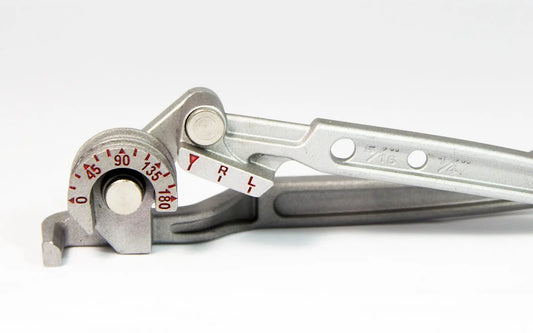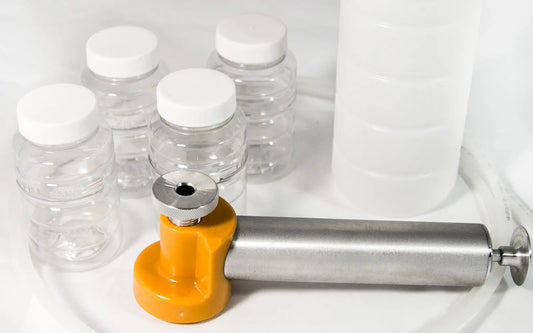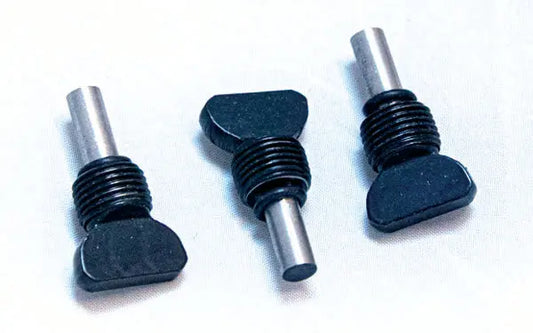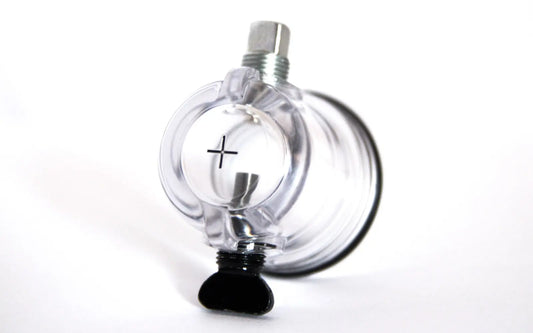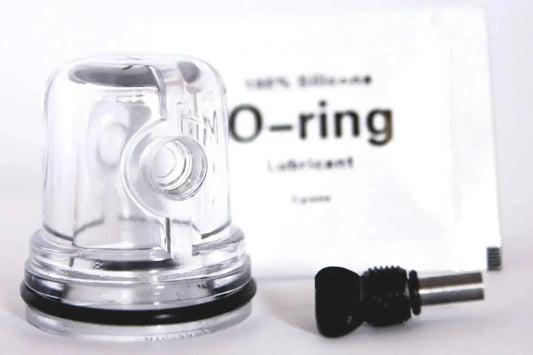- Identify appropriate location: Identify a port hole that is positioned at the oil level of your machine. Do not install the Pod below the oil level or on pressurized systems.
- Drop oil level: Drop the oil level of the machine below the port hole to prevent spillage during installation.
- Install Thread Reducer: Tightly thread the Reducer into the port hole of the machine using a wrench and thread sealer.
- Check sample valve orientation: Insert the Gasket into the female threads of Reducer. Hand thread the Pod into Thread Reducer until it makes contact with the Gasket. Note the down direction for bending the Pilot Tube.
- Bend pilot tube: Unthread the Pod from the Reducer and using the appropriate Tube Bender, bend the Pilot Tube down in the direction noted in the previous step. Choose a bend location and angle which best places the tip of the Pilot Tube within your machine for good sampling.
- Install CMP: Tightly thread the Pod into the Reducer until the Gasket is fully compressed. Thread sealing paste may also be used.
- Correct Sight Glass orientation: Thread the Corrosion Gauge into the Sight Glass port opposite the Magnetic Plug. Loosen the Locknut and rotate the Sight Glass so that the Magnetic Plug is at the bottom and the Corrosion Gauge is at the top. Hand tighten the Locknut. Note: Do NOT use thread sealer or thread locker on the Locknut. And DO NOT remove Locknut and Sight Glass unless for cleaning.
- Add oil: Check that all threaded components are tight and then replenish the machine with oil so that the oil is level with the cross hairs on the Sight Glass.
CONTENTS
Specs
INSTALLATION
USAGE
Warnings & DISCLAIMERS
DOWNLOADS
1 Luneta Pod Assembly
1 Thread Reducer
1 Magnetic Indicator
1 Corrosion Indicator
1 Manual
2 Viton Gaskets
| Application | Oil level ports |
|---|---|
| Threads | Varies (See Spec Sheet) |
| Shipping Weight | 1.2 Lbs each |
| Recommended Temperature | -40°F to 200°F (-40°C to 93°C) |
| Recommended Pressure | Low pressure applications |
| Outdoor Compatibility | UV resistant to protect against long term sun exposure |
| Chemical Compatibility | Mineral and synthetic oils compatible with Viton and PMMA® |
Materials
| Sight Glass | Tritan |
|---|---|
| Body | Anodized Aluminum |
| Magnet | Neodymium Rare Earth Magnet |
| Thread Reducer | Stainless steel |
| Pilot tube | Stainless steel |
| Sampling Valve | Zinc plated steel |
| O-rings | Viton |
| Gasket | Viton |
- The CMP is designed for use on pumps, gear boxes, hydraulic reservoirs, large vertical motors, and most other oil lubricated machinery.
- Check the CMP Sight Glass daily to ensure optimal lubricant and machine conditions. Note any changes in oil color, clarity, level, foam, debris, etc. A change, especially a rapid one, is not a good sign.
- Pull a sample using the attached Sampling Valve, and send it to the lab for further analysis.
- If ferrous debris is observed on the Magnet, then your machine's components are wearing down.
- If the Steel Indicator is corroded, then there is water in your machine and your oil's rust inhibitors have failed.
- Shining a laser through the oil in the Sight Glass can also reveal particles and debris.
- For use on center-line oil level ports only; Sight Glass should not be filled above the crosshair marking on the CMP during running conditions.
- Do not use on machines with oil temperatures outside the range of -40°F (-40°C) to 200°F (94°C).
- Do not use on machines with ambient temperatures outside the range of -40°F (-40°C) to 200°F (94°C).
- For use with mineral and synthetic oils compatible with fluorocarbon elastomers (Viton) and acrylic plastic (PMMA).
- Do not use on pressurized systems.
- Not for use on moving vehicles.
- Do not use on moving machine surfaces (e.g. reciprocating, oscillating, or rotating) or machines exposed to shock or fluid surge conditions.
- Do not use cleaning solvents incompatible with fluorocarbon elastomers (Viton) and acrylic plastic (PMMA).
- Do not stand on the CMP.
- Do not use or add an additional thread reducer bushing other than the one shipped with the CMP. This will result in errors in oil level measurement.
- Install the CMP on machine port locations that are a safe distance from moving machine parts, vehicles, and foot traffic.
- Luneta LLC is not responsible for for damages associated with incorrectly installing the CMP or for improper use as outlined in this manual and on the website Luneta.com.
Insight at a glance
Reliability in every drop

#1. Pilot Tube
Ensures consistent sampling from the live zone

#2. SAMPLING VALVE
The Luneta Pod features a standard MINIMESS® fitting for sampling

#3. Thread Reducer
Allows for installation of the Pod on most pieces of machinery

4
Steel Corrosion Indicator
The steel corrosion indicator rests above the oil level to monitor for moisture in the headspace of your machine.
If it rusts or corrodes, then you know there is an issue within the equipment.
5
Tritan Sight Glass
Tritan is an incredible material, it simply does not crack or break under field conditions.
Luneta's Sight Glasses are made with an engraved crosshair design that allows for easy oil level monitoring.
The Sight Glass used by Pod contains the two indicators for condition monitoring.
6
Magnetic Plug
The Magnetic Plug rests under the oil level of your machine and collects any ferrous debris that floats by.
If you observe particles stuck to the magnet, then you know there is a problem with the equipment.

#4. Steel corrosion Indicator
Corrodes in the presence of water to alert you to issues with your lubrication

#5. TritAN SIGHT GLASS
Same material and shape as our beloved Sight Glass, but with more versatility.

#6. Magnetic Plug
The Luneta Pod features a rare earth magnet to catch ferrous wear debris
Customers Also Bought
Frequently Asked Questions
What keeps the Sight Glass in place?
The locknut provides adequate pressure to keep the Sight Glass securely in place.
Does the sampling valve have to be installed pointing up?
No! You can install the port in whatever direction makes the most sense for your operation. It will be able to dispense oil from any angle.
Why can't I purchase a Pod smaller than 1/2" diameter?
The thread reducer must be 1/2" or greater to allow for the pilot tube to pass through properly. Otherwise the oil level will not display properly.
Do I have to drain the machine to take out the indicators for viewing?
No! Luneta's patented design allows you to rotate the indicators up out of the oil so they can be removed without spilling oil.
Still have questions?
Fill out the form below and we will get back to you soon, usually within 24 hours.






